Myofascial Pain Syndrome in Women with Primary Dysmenorrhea: A Case-Control Study
- PMID: 36359567
- PMCID: PMC9689409
- DOI: 10.3390/diagnostics12112723
Myofascial Pain Syndrome in Women with Primary Dysmenorrhea: A Case-Control Study
Abstract
There is limited information on myofascial trigger points (MTrPs) and specific symptoms of chronic pelvic pain and, more specifically, dysmenorrhea. The objective of this study was to determine whether patients suffering from primary dysmenorrhea present alterations in mechanosensitivity and pain patterns, and greater presence of MTrPs in the abdominal and pelvic floor muscles. A case-control study was carried out with a total sample of 84 participants distributed based on primary dysmenorrhea and contraceptive treatment. The sample was divided into four groups each comprising 21 women. Data on pain, quality of life, and productivity and work absenteeism were collected; three assessments were made in different phases of the menstrual cycle, to report data on pressure pain threshold, MTrP presence, and referred pain areas. One-way ANOVA tests showed statistically significant differences (p < 0.01) between the groups, for the Physical Health domain and the total score of the SF-12 questionnaire, and for all the domains of the McGill questionnaire; but no significant differences were found in the data from the WPAI-GH questionnaire. Statistically significant data (p < 0.01) were found for mechanosensitivity in the abdominal area and limbs, but not for the lumbar assessment, within the group, with very few significant intergroup differences. The frequency of active MTrPs is higher in the groups of women with primary dysmenorrhea and during the menstrual phase, with the prevalence of myofascial trigger points of the iliococcygeus muscle being especially high in all examination groups (>50%) and higher than 70% in women with primary dysmenorrhea, in the menstrual phase, and the internal obturator muscle (100%) in the menstrual phase. Referred pain areas of the pelvic floor muscles increase in women with primary dysmenorrhea.
Keywords: mechanosensitivity; myofascial pain syndrome; myofascial trigger points; pain pressure threshold; primary dysmenorrhea.
Conflict of interest statement
The authors of this study declare no conflict of interest.
Figures


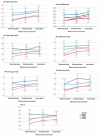

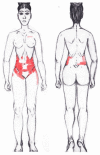
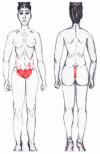
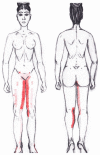
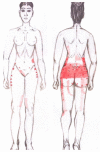

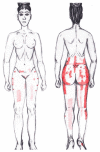
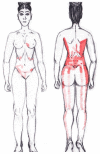










Similar articles
-
The prevalence of primary dysmenorrhea among students and its association with musculoskeletal and myofascial pain.J Bodyw Mov Ther. 2019 Oct;23(4):785-791. doi: 10.1016/j.jbmt.2019.05.006. Epub 2019 May 14. J Bodyw Mov Ther. 2019. PMID: 31733762
-
Tensiomyography, sonoelastography, and mechanosensitivity differences between active, latent, and control low back myofascial trigger points: A cross-sectional study.Medicine (Baltimore). 2017 Mar;96(10):e6287. doi: 10.1097/MD.0000000000006287. Medicine (Baltimore). 2017. PMID: 28272251 Free PMC article.
-
Abdominal skeletal muscle activity precedes spontaneous menstrual cramping pain in primary dysmenorrhea.Am J Obstet Gynecol. 2018 Jul;219(1):91.e1-91.e7. doi: 10.1016/j.ajog.2018.04.050. Epub 2018 May 5. Am J Obstet Gynecol. 2018. PMID: 29733841 Free PMC article.
-
What we know about primary dysmenorrhea today: a critical review.Hum Reprod Update. 2015 Nov-Dec;21(6):762-78. doi: 10.1093/humupd/dmv039. Epub 2015 Sep 7. Hum Reprod Update. 2015. PMID: 26346058 Review.
-
Myofascial Pelvic Pain: An Overlooked and Treatable Cause of Chronic Pelvic Pain.J Midwifery Womens Health. 2021 Mar;66(2):148-160. doi: 10.1111/jmwh.13224. Epub 2021 Mar 31. J Midwifery Womens Health. 2021. PMID: 33788379 Review.
Cited by
-
Evaluating the Effectiveness of Radiofrequency in Multimodal Physiotherapy for Postpartum Pelvic Pain: The RASDOP Protocol-A Mixed-Methods Study.J Clin Med. 2025 Feb 23;14(5):1489. doi: 10.3390/jcm14051489. J Clin Med. 2025. PMID: 40094952 Free PMC article.
-
Effects of warm silver needle acupuncture combined with myofascial trigger point intervention on peripheral neutrophil autophagy and alleviation of chronic pelvic pain in women.Am J Transl Res. 2025 Apr 15;17(4):2885-2897. doi: 10.62347/BZLD8847. eCollection 2025. Am J Transl Res. 2025. PMID: 40385058 Free PMC article.
References
-
- Hurtado B.G., Chillón-Martínez R., Roldán J.R., Orta-Perez M. Dismenorrea primaria y fisioterapia. Fisioterapia. 2005;27:327–342. doi: 10.1016/S0211-5638(05)73458-1. - DOI
-
- Larroy C., Crespo M., Meseguer C. Dismenorrea Funcional En La Comunidad Autónoma de Madrid: Estudio de La Prevalencia En Función de La Edad. Rev. Soc. Esp. Dolor. 2001;8:11–22.
-
- Abarca L., Molero J.M., Casimiro C. Dismenorrea. Una revisión multidisciplinaria en el contexto de la medicina basada en la evidencia. FMC. 2006;13:550–559. doi: 10.1016/S1134-2072(06)71400-1. - DOI
LinkOut - more resources
Full Text Sources

